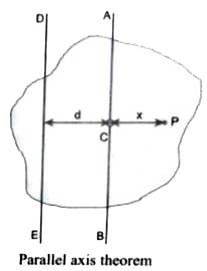State and prove parallel axis theoremSolution in Tamil
Parallel axis theorem: Parallel axis theorem states that the moment of inertia or a body about any axis is equal to the sum of its moment of inertia about a parallel axis through its center of mass and the product of the mass of the body and the square of the perpendicular distance between the two axes.
If IC is the moment of incrliu oflhe body of mass M about an axis passing through the center of mass then the moment of inertia I about a parallel axis at a distance d from it is given by the relation
I=IC=md2
I=IC+Md2
Let us consider a rigid body as shown in figure. Its moment of inertia about an axis AB passing through the center of mass is IC . DE is another axis parallel to AB at a perpendicular distance d from AB. The moment of inertia of the body about DE is I . We attempt to get an expression for I in terms of IC . For this, let us consider a point mass m on the body at position x from its center of mass
The moment of inertia of the point mass about the axis DE is m(x+d)2 The moment of inertia I of the whole body about DE is the summation of the above expression.
I=∑m(x+d)2
This equation could further be written as,
I∑m(x2+d2+2xd)
I=∑(mx2+md2+2dmx)
I=∑mx2+∑md2+2d∑mx
Here ∑mx2 is the moment of inertia of the body about the center of mass. Hence . IC=∑mx2
The term ∑mx=0 because, x can take positive and negative values with respect to the axis AB. The summation (∑mx) will be zero .
Thus I=IC+(∑mx) will be zero .
Thus I=IC+∑md2=IC+(∑m)d2
Here ∑m is the entire mass M of the object (∑m=m)
I=IC+Md2

Topper's Solved these Questions
- EXAMINATION QUESTION PAPER MARCH 2019BOOK - FULL MARKSCHAPTER - EXAMINATION QUESTION PAPER MARCH 2019EXERCISE - PART-III
9 Videos
- EXAMINATION QUESTION PAPER - JUNE 2019BOOK - FULL MARKSCHAPTER - EXAMINATION QUESTION PAPER - JUNE 2019EXERCISE - PART IV
10 Videos
- GRAVITATIONBOOK - FULL MARKSCHAPTER - GRAVITATIONEXERCISE - ADDITIONAL QUESTIONS SOLVED (Numerical Problems)
18 Videos
Similar Questions
What is the torque of the force →F=3ˆi−2ˆj+4ˆk acting at a point →r=2ˆi+3ˆj+5ˆk about the origin?
View SolutionExplain in detail the triangle law of addition.
View SolutionA geo-stationary satellite is orbiting the Earth of a height of 6R above the surface of Earth R being the radius of the Earth calculate the time period of another satellite at a height of 2.5R from the surface of Earth.
View SolutionState and prove theorem of parallel axes.
View SolutionState and prove theorem of parallel axes.
View SolutionState and prove parallel axis theorem.
View SolutionState and prove parallel axis theorem
View SolutionState and prove parallel axis theorem
View SolutionState the theorem of parallel axis.
View SolutionState and explain parallel axis theorem and perpendicular axis theorem.
View SolutionState and prove parallel axis theorem
View SolutionState and prove perpendicular axis theorem.
View SolutionState and prove parallel axis theorem
View SolutionState and prove parallel axis theorem
View SolutionState and prove perpendicular axis theorem.
View Solution
